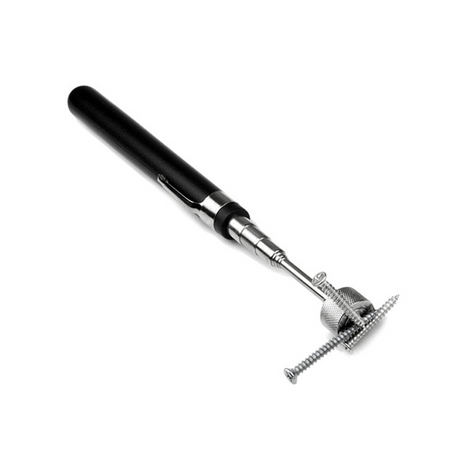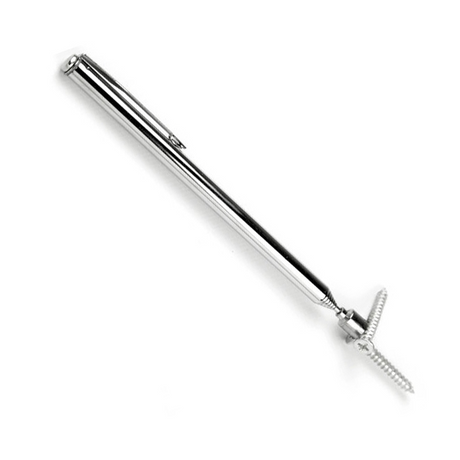We have spent a few months completely rebuilding our showroom, so that there is an opportunity to show even more magnet solutions at have a workshop to make tests for customers with various magnet solutions at the same time.
New magnetic tool wall
We are really happy with our new tool wall, which is of course built using magnets. Here is a large photo of the entire solution, and further down the page we explain how we have hung the various things.
Small tools require small magnets
17x4 mm. rubber magnets:
Scissors and screwdrivers are usually made of magnetic metal and can therefore hang directly on the magnet. We have placed them separately, but the magnet is strong enough to have both parts hanging on the same magnet. This means that you would also be able to hang several screwdrivers on the same magnet.
The foldable yardstick is assembled with a metal split so that it can be hung magnetically directly on the magnet, but the ordinary ruler is made of plastic, and therefore we have put the magnet on the outside of the ruler to be able to hang it up magnetically.
And finally there is the package of screws, which are also magnetic. Therefore, we have been able to put a magnet directly on the metal plate, which the screws adhere to through the packaging. However, this cannot be done with aluminum screws.
Hook magnets:
At the bottom, we have hung a bag with screws on a Ø10 magnetic hook. At the top we have hung ear muffs on a Ø32 hook. The ear protection does not need such a strong magnet, but this solution provides a larger hook, which is useful for hanging many things, even when you are not using the space for the muffs.
Ludo Maxi magnet:
It is practical to have work gloves close at hand, and we have hung them up with a Ludo Maxi magnet on the outside.
17x12 mm. rubber magnets:
The pliers are a bit heavier and therefore need a slightly stronger rubber magnet. We also balanced our spirit level on some 17x12 magnets - mostly because the height must be used to achieve full balance at the bottom, and then we have put a 22x6 mm. rubber magnet at the top, where you could also choose to use a 17x12 mm. magnet for better stability/retention.
You could also glue a magnet to the spirit level directly - then only a magnet that can support 2-4 times the weight of the spirit level (to cope with the downward pull) must be used. However, this spirit level is not made magnetic and therefore balances on magnets instead, so it can still be easily taken down from the tool wall.
22x11 mm. rubber magnets:
Below we show the setup of things that are heavier and therefore require stronger magnets. The saw, the set of unbraco keys, the pop rivet pliers and the loose tool are all magnetic and can sit directly on each magnet. The drill set consists of a plastic box with a metal drill in it, and the magnet must therefore work through the plastic box, which is why a slightly stronger magnet is needed (distance weakens the magnetism). The magnet therefore sits directly on the board, and the box is then placed on top and works well magnetically.
The top key and the loose umbraco keys are put together to show that you can also assemble several pieces of tool on the same magnet by using a slightly stronger magnet.
22x6 mm. rubber magnets:
Our hammer is quite heavy so it needs 2 magnets on the back of the head. Next to it is a magnet to collect screws and nails (pick up screws and nails from the table and floor with the magnet and then put it on the board so that they are kept together and are easy to find when you need to use them again).
Finally, we have hung a top key set that is stuck in a rubber gasket, but where the magnet can catch the keys through the rubber. The set itself is not that heavy and could be content with hanging on a smaller magnet if there was direct contact between metal and magnet, but the rubber gasket creates a distance that requires stronger magnetic force.
Magnetic tools - how to avoid it
There are many advantages to tools being magnetic (magnetised by contact with strong magnets). Metal screws stick to the screwdriver when you need to screw something in, metal nails stick to the hammer for centring the first hit, etc. And then you can have a small magnet attached to your screwdriver to hold extra tool bits or loose screws.
But if you don't want your hammer or screwdriver to remain magnetic from having been in contact with a strong magnet, then you just have to give the tool a few hits on the edge of a workbench or on the floor, and then the poles are "confused" again, and your tool is unmagnetic. There is no reason to invest in expensive demagnetisation rails or to opt out of using magnets in everyday workshop and warehouse work.
Need guidance?
There can be huge differences in how much tools weigh. We are happy to help calculate and/or test what you need for your own tool wall. It's always a good idea to have a few different magnets, as you will most likely find many more things that you can organize on your tool wall once you get started. Feel free to contact us for help with your magnetic tool wall.























































